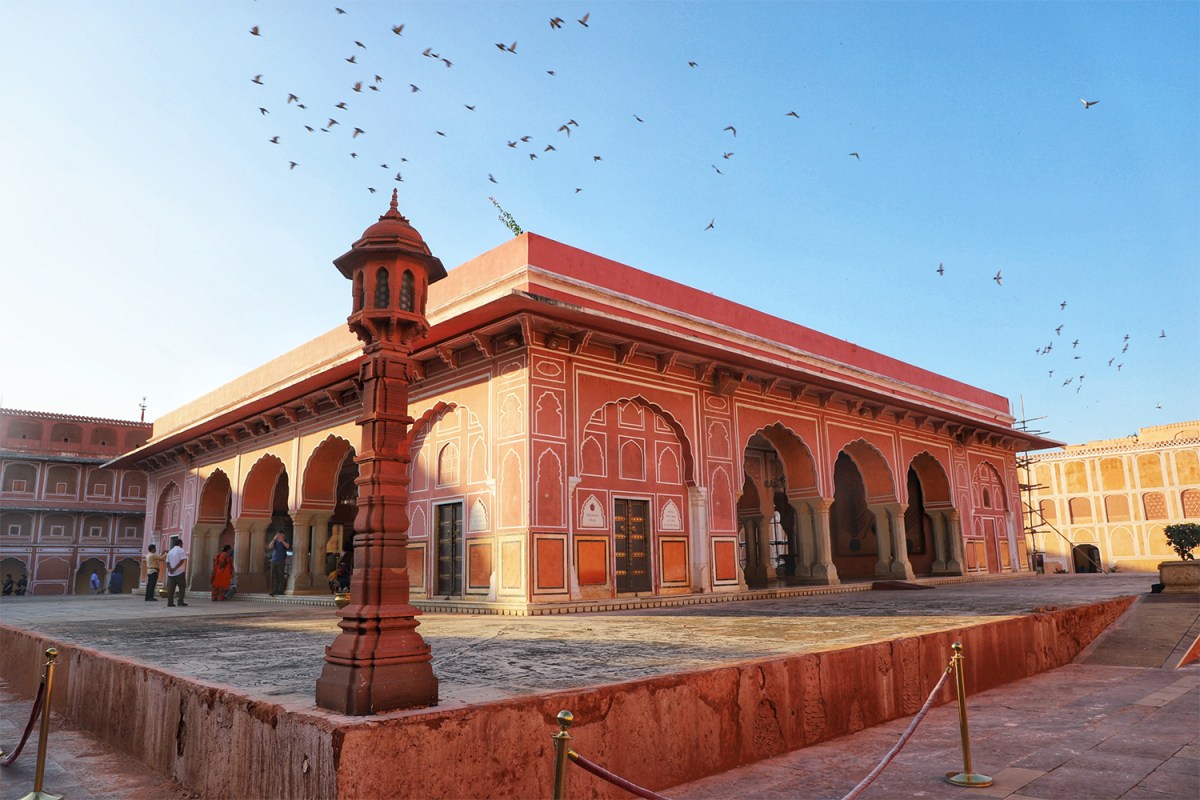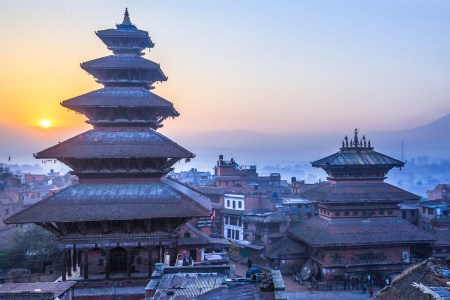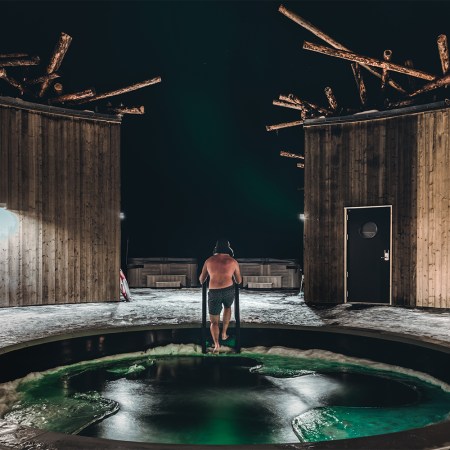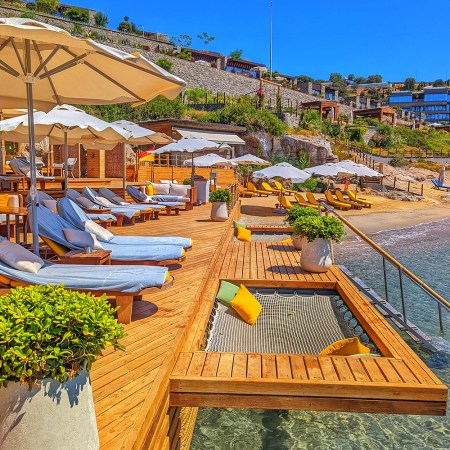Hidden away in Old Delhi’s tangled web of alleys, and far removed from the glitzy five-star hotels tucked into their private walled compounds in New Delhi, properties kept quiet and pristine behind layers of walls and security, is Haveli Dharampura. The hotel is a renovated, multi-story Indian manor house, transformed into an extravagant escape from the city surrounding it.
On this warm mid-October evening, its ground floor restaurant, Lakhori, is playing host to a farewell dinner at the end of an Intrepid Travel trip to India. It was arranged by our guide Mahaveer, a well-known mover and shaker from Rajasthan in the north; he’s exactly the kind of person you want as a group leader when visiting a place in which you’d otherwise be completely lost. The dinner begins with several rounds of traditional Delhi bites and flavors rejiggered into modern interpretations, ahead of a bountiful family-style feast.
The meal is set within the haveli’s central courtyard, but as the night unfolds, our group tours its rooftop where a splendid, little-seen view of Delhi at night reveals itself, the domes and minarets of Jama Masjid, one of the largest mosques in the country, glowing brightly in front of us, appearing almost as a movie set dropped into a location with which it bears no resemblance. A local dance and music performance gets underway, and we bask in what’s been an enchanting evening filled with stories and friends and food and drink.
The serene night was all the more delightful because of what it stood in juxtaposition to: the absolute madness and unending clamor of Old Delhi’s Chandni Chowk. To reach the haveli, we waded through narrow passageways packed shoulder to shoulder with passersby, crossed streams of gridlocked traffic honking in a deafening cacophony, lost our way and backtracked and turned around and started again, losing a group member here, finding her back there, petting a stray dog, dodging a rickshaw and another and a motorbike and then a dozen more, while avoiding splashes from who knows what type of liquid has been accumulating in the gutters.
The noise, the crowds, the lack of personal space, the tantalizing smells of sizzling foods from street vendors and the acrid ones redolent of pollution and smog and litter…it’s a lot. The fact that two such different worlds can coexist beside one another, and that you can partake in them over the course of a single day, or even a single hour, is what makes a trip to India at large and Delhi in particular so worthwhile.
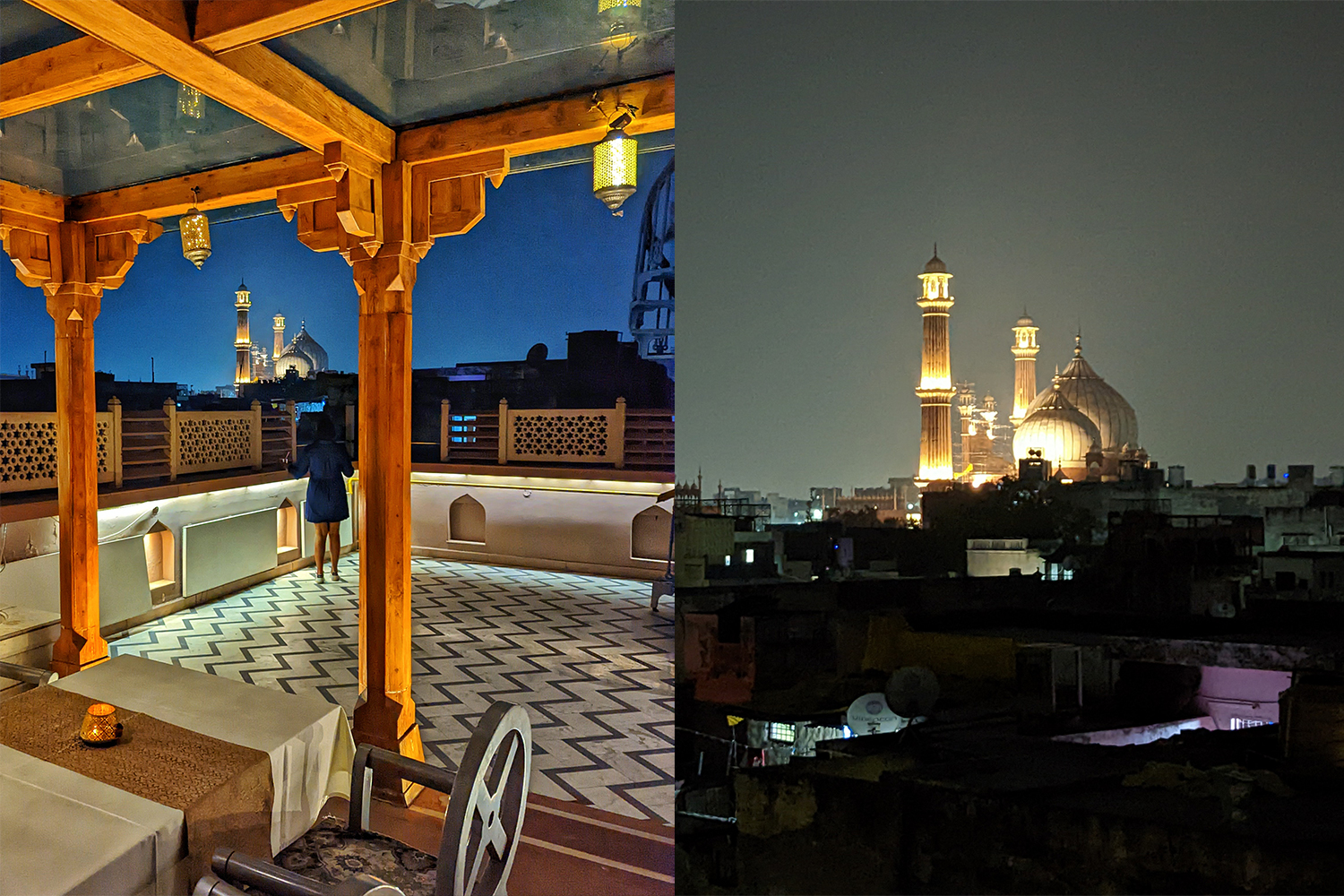
Planning a Trip to India
Even for a seasoned traveler, this part of the world grabs your comfort zone and rips it away, throwing it on the street and forcing you to watch as the city tramples over it. Whether that’s a liberating or paralyzing experience is up to you, and perhaps dependent on whether or not you have a guide like Mahaveer.
The aforementioned evening was one small piece of an 18-day trip spent with Intrepid Travel, billed as their Premium India & Nepal itinerary. It’s actually a combination or two separate trips, one in the former country and one in the latter, which can optionally be booked together. While I was the only traveler from the opening India leg to continue onto Nepal, four people from my Nepal itinerary had tacked on Intrepid’s Premium Bhutan experience on the back end of their journey. You could stack all three together if you wanted, or mix and match itineraries as you see fit; another traveler departed our Northern India circuit to head to a lengthy South India sojourn with the travel company.
The “premium” tag itself indicates an elevated level of style and standards while traveling, with, for instance, private buses and vans as opposed to public transport, and with short flights replacing the slog of overnight trains. Trips are led by the company’s best and most experienced guides, and the accommodations are elevated, with each itinerary including a stay at a high-end hotel that’s memorable and evocative of its destination.
Premium itineraries are a relatively new offering from Intrepid and have proven to be a hit, combining the operator’s sense of wanderlust and adventure with a bit of a softer touch. As such, they’ve expanded on the range, now including 97 premium trips across 42 countries and five continents. Intrepid also claims carbon-neutral status, and is recognized as the world’s largest travel-specific B Corp. The organization assesses environmental practices as well as social impact, and a major part of any Intrepid itinerary is a chance to see and live some of their initiatives in action.
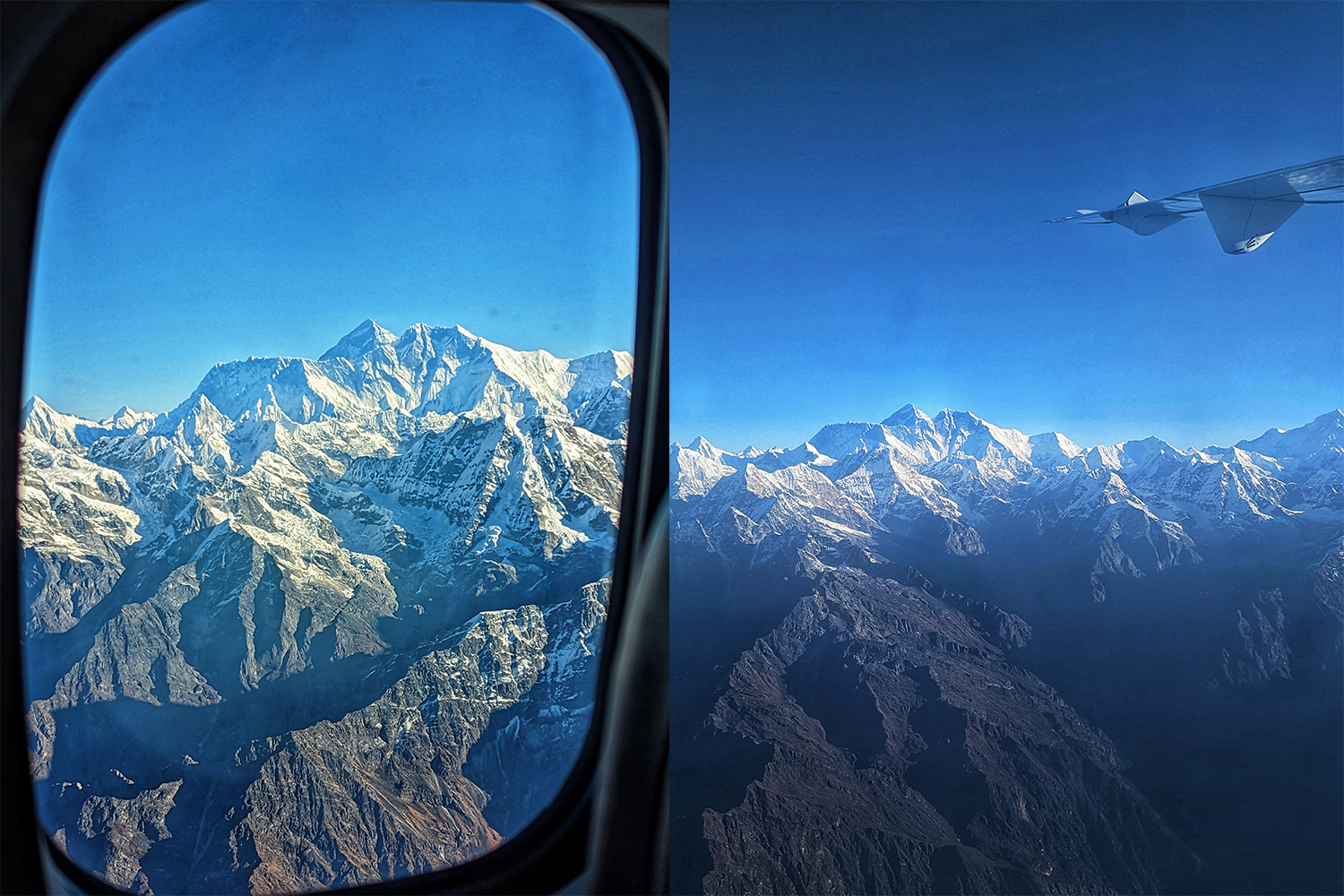
Bird’s Eye Views and Warm Welcomes
If the revelry of the haveli dinner, contrasted with the chaos of Old Delhi, was among the most memorable moments from India, the trip to Nepal peaked right at the start: with a scenic flight by Mount Everest. Yeti Airlines — gotta love it — operates multiple morning flights, with the destination shown on airport screens as “Mountain,” that fly from Kathmandu towards Mount Everest before looping back to the city.
Three flight attendants were on board, though instead of serving drinks, they walked up and down the aisles pointing out mountain peaks. Only window seats are sold on these flights, and depending on your position, you’ll either enjoy an up-close view of Everest and the rest of its brethren Himalayan behemoths coming or going. The flights are weather dependent, so hope for clear skies, as well as defogged windows.
The sheer immensity and power of the mountains are hard to grasp and the beauty bestowed by such forces of nature are unmatched. And while it’s all the rage for every tech bro with a two-week sabbatical to try to scale the beast himself, along with hundreds of his closest friends in a chain latched onto the same rope stretching to the horizon, this aerial excursion more than satiated my curiosity.
Each half of my journey with Intrepid included a stint at a national park. In India, we visited Ranthambore; in Nepal, our destination was Chitwan. Much hoped for tigers didn’t make an appearance in either locale, though each setting and its abundance of nature and wildlife, seemingly on different planets from the bustling cities and roads you pass through to reach them, were worthy of seeing on their own merits.
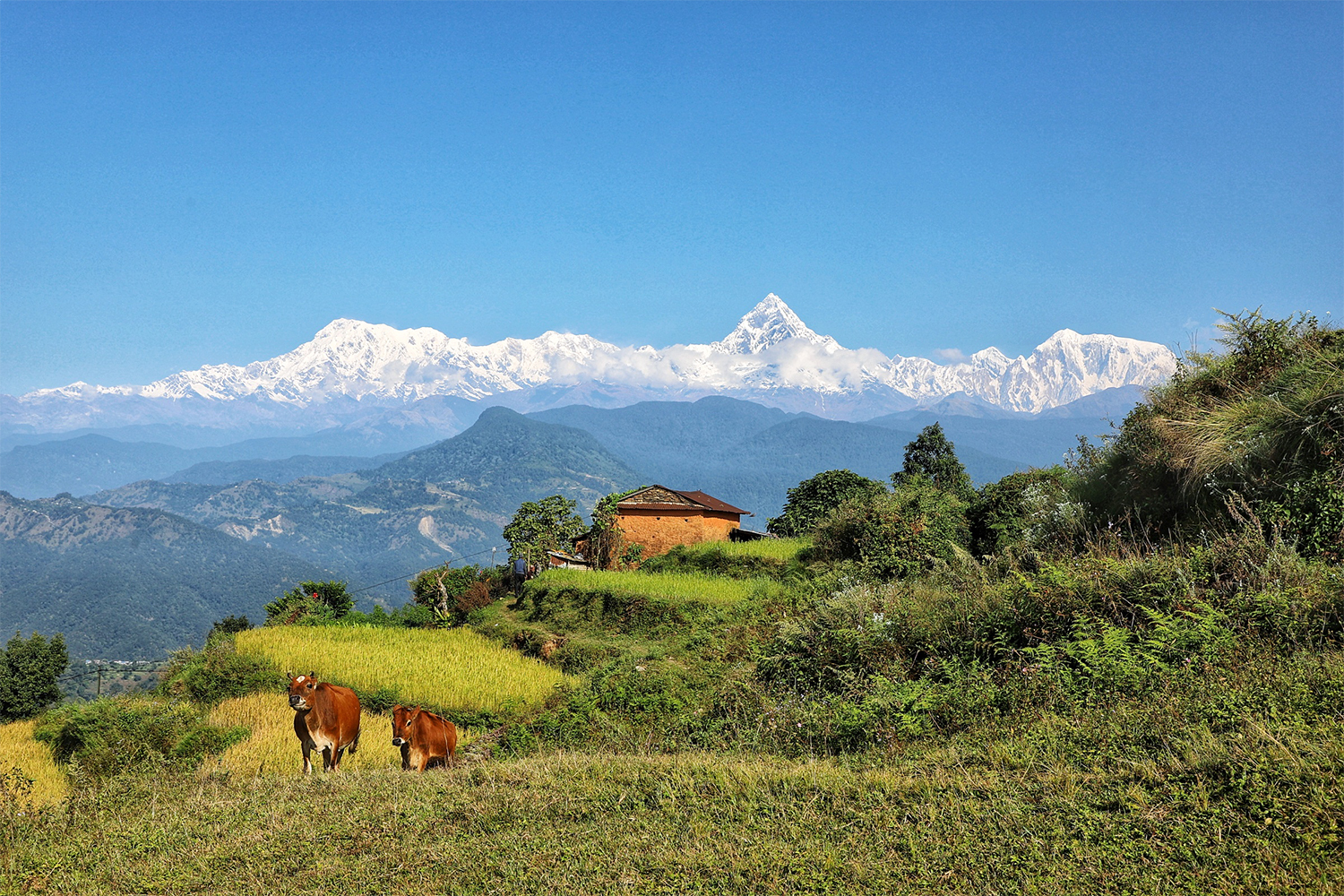
Nepal’s signature sites include scores of temples, pagoda-lined city squares, and Buddhist stupas, or domed shrines. The city of Pokhara is nestled alongside the second biggest lake in the country, Phewa, with the Himalayas lurking in the background. It’s an area filled with a huge assortment of recreational opportunities, which you should take advantage of.
“These are the hills, not the mountains,” our guide Ram tells us as we’re traversing a path at an elevation of about 6,000 feet. “Mountains are the snow-capped ones.”
Why You Should Take a Trip to Kathmandu – Nepal’s Overlooked Capital City
Kathmandu is the gateway to Everest, but there’s plenty of reasons to go — even if you’re not planning a trekBut the most indelible and lasting images from the country weren’t those sites and structures, but the people who we had a chance to meet. At a Tibetan refugee camp in Pokhara, a woman named Dolma welcomed our group into her home for a momo cooking class, momos being the traditional Tibetan dumplings that are ubiquitous in Nepal. Her parents fled Tibet 60 years ago, and she was born and raised in this camp, with little recourse to build a new life elsewhere.
“The Tibetan people here survive by selling souvenirs and momo cooking classes, little bit by little bit,” she says. “There are no other jobs.” Yet a smile and a hug from her, gestures which come so easily — not to mention a few rounds of her veggie and potato dumplings — can lift up your day and change your perspective in a flash.
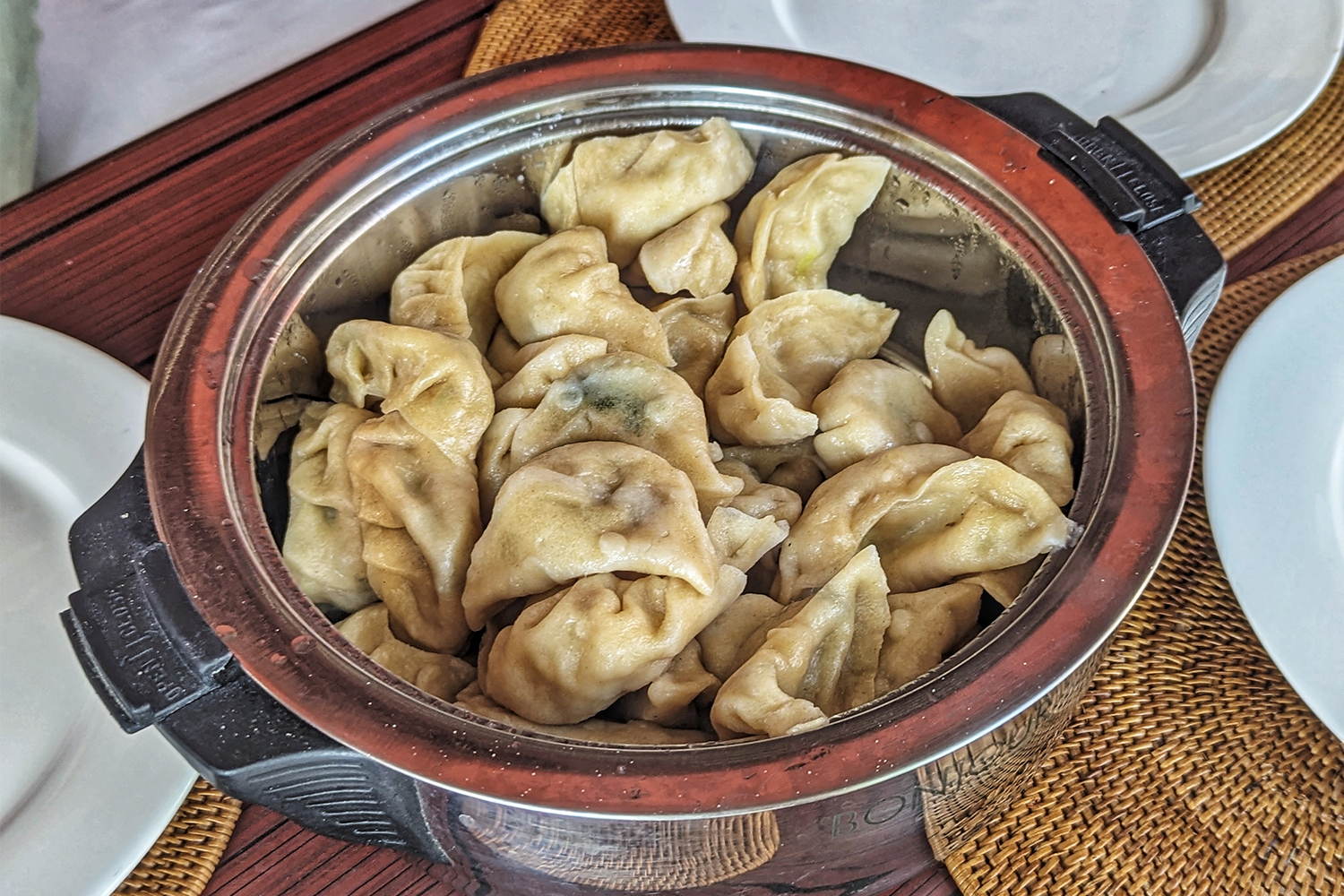
At Seven Women in Kathmandu, our group took a half-day cooking class from the foundation, which helps marginalized women with skills training, education and employment. We helped make half a dozen dishes while learning about the organization, meeting the women and getting a chance to learn how to write our names in sanskrit along the way. The Nepalese spice base of fenugreek, garlic, onion, cumin, coriander, turmeric and chilies appeared in one nourishing dish after another. After getting in the habit of eating meals based around Dal Bhat, or Nepalese lentils and rice often served with a half-dozen sauces, sides and accompaniments, you’ll learn to appreciate the phrase “Dal Bhat Power 24 Hour” that’s seen on T-shirts and trekkers across the country.
In India, there were other opportunities for local immersion. On one occasion, we met with a woman named Divyashree Joshi, who hosts dinners and cooking classes showcasing Brahmin cuisine from her multi-generational home in Jaipur. Vegetarian dishes are prepared without garlic and onion, but are loaded with rewarding flavor, served on silver platters piled high with almost a dozen different bites consisting of okra, beans, radishes, mangoes, potatoes, cauliflower, rice and more. We visited the Sikh temple Gurudwara Sis Ganj Sahib in Delhi, and participated in langar, the free meal served by its community kitchen. Any visitor is welcome to come and eat as much as they please, as long as they eat everything that’s served to them. It’s a setting where a humble, nourishing plate of food becomes a communal experience that breaks down barriers and highlights how the simplest of things can sometimes be the most essential and rewarding.
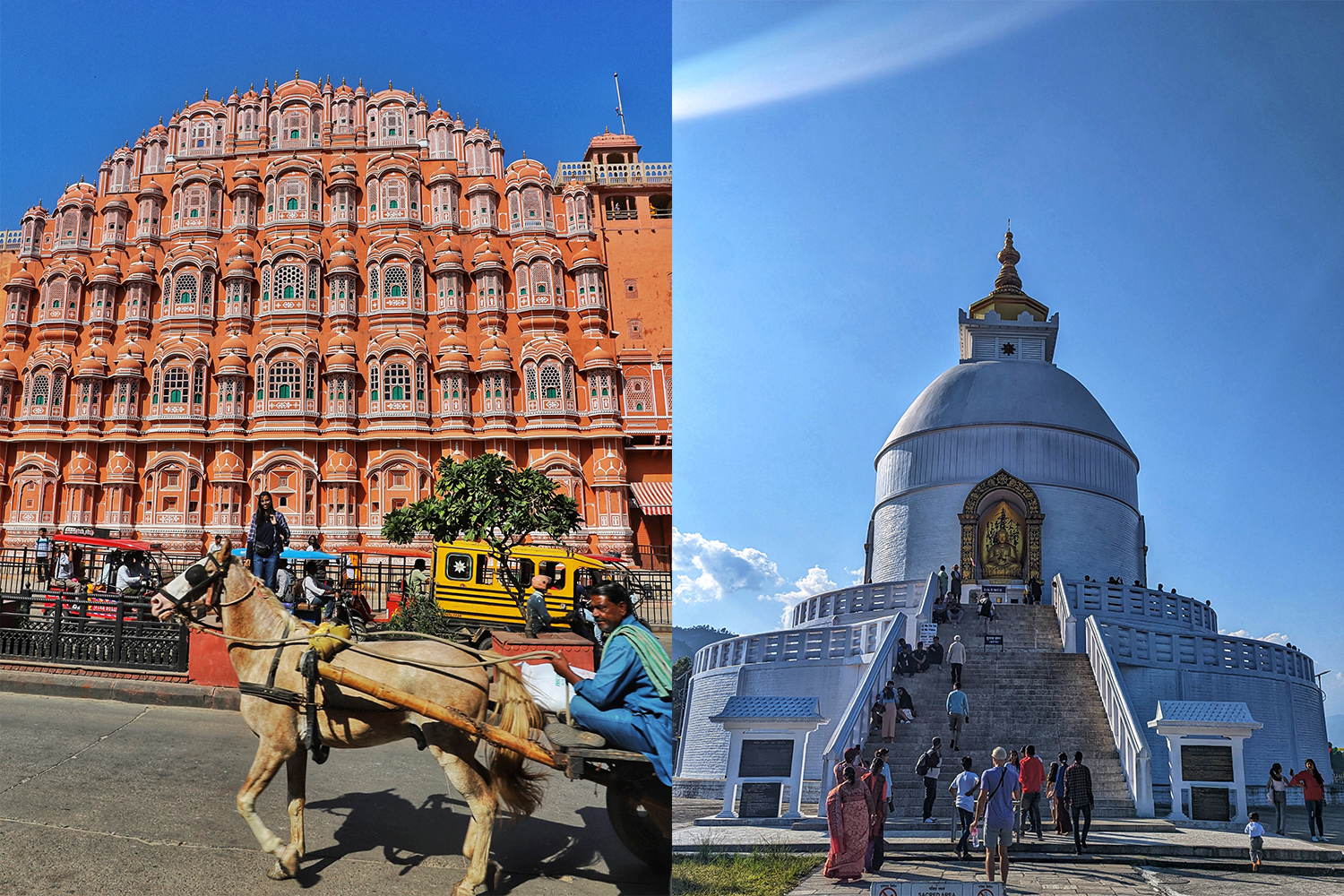
Jaipur, Varanasi and the Taj Mahal
When I told people I was traveling to India, with near unanimity the destination that was met with the most excited response was Jaipur, the “Pink City.” The entire walled old city is a UNESCO World Heritage Site, and while traversing the town I felt like a video game character wandering a fantasy landscape of bright colors and ornate buildings, fascinating sights and sounds. Let’s say Link in Ocarina of Time, not just because it was the formative game of my N64-fueled middle school years, but because the city boasts a Water Palace, built in the middle of a lake, as well as a Palace of the Winds, among other palaces and mountain forts galore, and nothing but pink and terracotta as far as the eyes can see. (Fellow gamers will see the similarities.)
Jaipur’s old city may be busy, but Varanasi is in a category of its own, pulsing with the omnipresent energy from throngs of religious pilgrims. “Varanasi has a longer history than India, and thousands of pilgrims come every day,” Mahaveer says as we’re approaching the city for the first time. “And people will be carrying dead bodies next to you in the streets.”
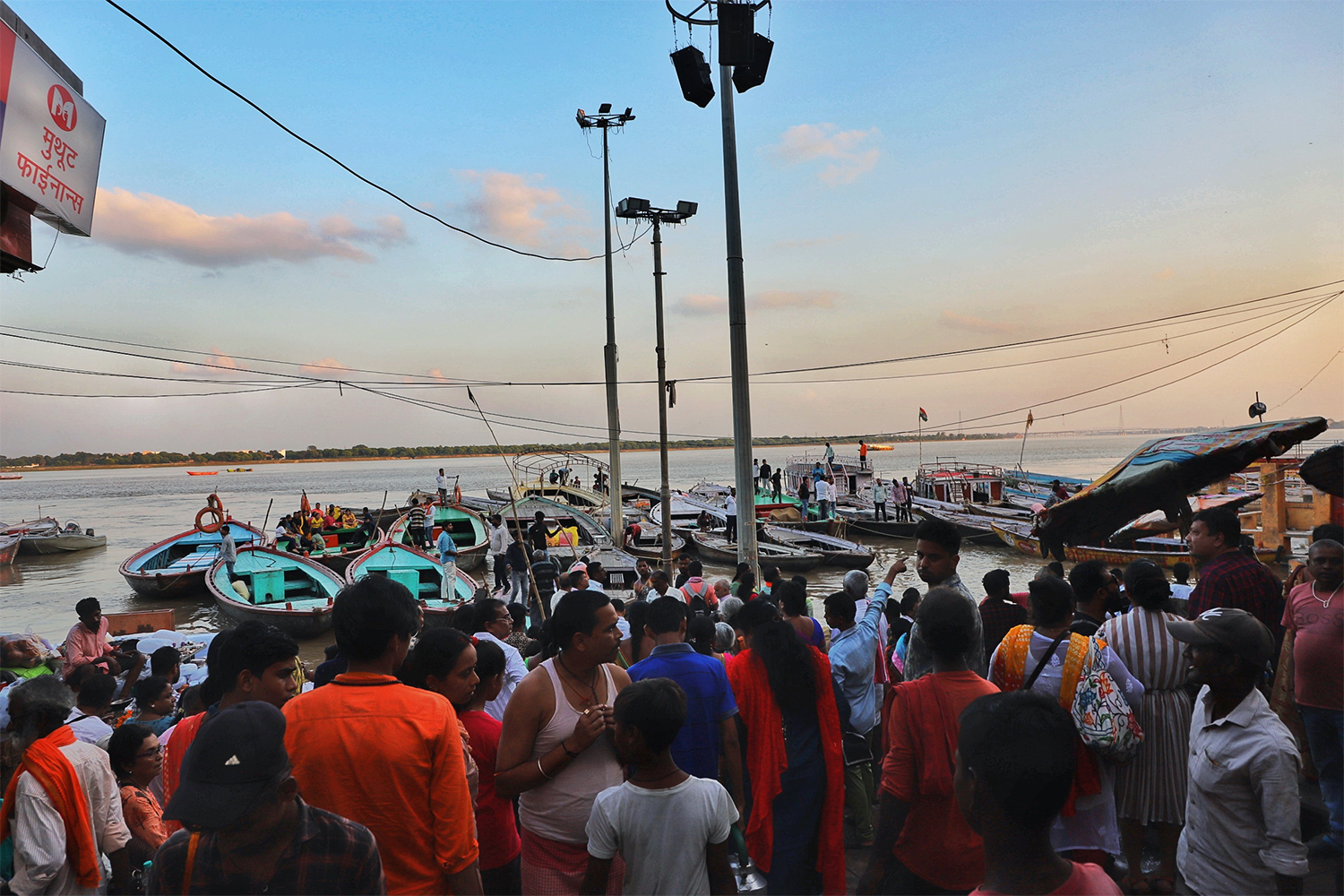
Now that’s an introduction. The city, previously known as Benares or Banaras, and in ancient times as Kashi, has been inhabited for at least 2,500 years and likely closer to 4,000. It’s believed that the Buddha gave his first sermon in adjacent Sarnath, where a major stupa was constructed 1,500 years ago to mark its locale. But even more importantly, Varanasi plays a major role in Hinduism, as it’s believed that being cremated in the location, with one’s ashes dispersed into the Ganges River, allows one to break the karmic cycle of rebirth. There’s therefore a nonstop procession, day in and day out, of families toting their deceased loved ones to the ghats where cremation ceremonies take place alongside the river’s steep banks.
There’s a fever pitch to the city, with a crush of humanity and cows in the streets, the smell of smoke in the air, visible ashes fluttering in the wind as you move from the outskirts closer and closer to the water. And indeed, bodies are being carried on stretchers aloft overhead, ornately adorned in bright colors as their pallbearers chant “Ram Naam Satya Hai,” which can be translated to “the name of Rama is truth,” or “truth is the name of Lord Rama.”
Prayer rituals called Aarti are conducted each morning and night alongside the banks of the river. The morning rendition is relaxed, sparsely attended and marked by yoga, while the evening ritual attracts hundreds packed onto the streets and viewing from boats, with drumming, chanting and clapping alongside fire, incense, candles and smoke. It makes for a captivating performance, shocking when you realize that something of this magnitude is held two times per day, every day.
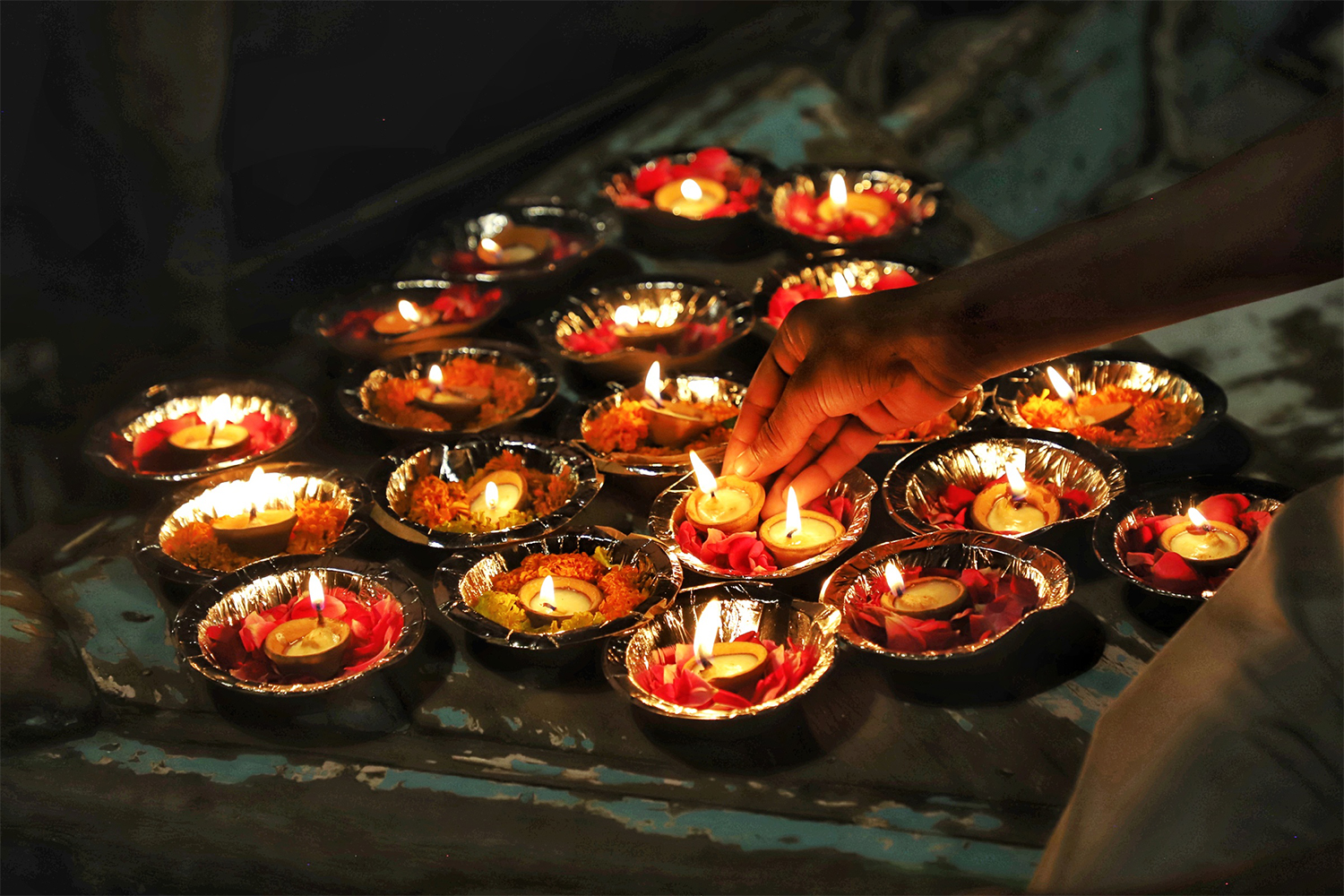
It’s impossible to try to come to a resolution about the mark a place like this leaves on you. Mahaveer, always ready with a useful piece of knowledge, chimes in. “The main philosophy is ‘do good and forget,’” he says of karma. You can’t do good for a reason, or care about the response or benefit. But being able to free one’s soul from the karmic circle, to gain what could be considered some form of eternal peace, is the ultimate objective. It’s why a person approaching their end may willingly travel to Varanasi in order to die there. It’s why an endless line of pilgrims come with their deceased in an attempt to send them to a better plane.
On perhaps the other end of India’s tourism spectrum, we visited the Taj Mahal, and the majestic site certainly lives up to its billing. It’s something which must be felt more than seen. The building and its grounds, with their iconic symmetry and painstaking attention to intricate detail, have a palpable presence. It’s why photos do the compound no justice; you have to walk its perfect paths and ponder its creation and the enormity of such a task, as well as the meaning behind it and the tragic aftermath, to try to understand what makes it so compelling and powerful.
With 18 days of nonstop adventuring and sightseeing, eating and touring, learning and conversing, I could recount a litany of additional standout memories and singular moments. That’s not the point though. This type of trip is less about the day-to-day activities than it is the grand sum of the feeling with which you’re left. The soul satisfied, the need for adventure satiated, the heart full. The desire to come back and do it again? Already burning.
This article was featured in the InsideHook newsletter. Sign up now.
